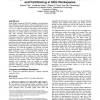Free Online Productivity Tools
i2Speak
i2Symbol
i2OCR
iTex2Img
iWeb2Print
iWeb2Shot
i2Type
iPdf2Split
iPdf2Merge
i2Bopomofo
i2Arabic
i2Style
i2Image
i2PDF
iLatex2Rtf
Sci2ools
CSCW
2004
ACM
2004
ACM
Avoiding interference: how people use spatial separation and partitioning in SDG workspaces
Single Display Groupware (SDG) lets multiple co-located people, each with their own input device, interact simultaneously over a single communal display. While SDG is beneficial, there is risk of interference: when two people are interacting in close proximity, one person can raise an interface component (such as a menu, dialog box, or movable palette) over another person’s working area, thus obscuring and hindering the other’s actions. Consequently, researchers have developed special purpose interaction components to mitigate interference techniques. Yet is interference common in practice? If not, then SDG versions of conventional interface components could prove more suitable. We hypothesize that collaborators spatially separate their activities to the extent that they partition their workspace into distinct areas when working on particular tasks, thus reducing the potential for interference. We tested this hypothesis by observing co-located people performing a set of collaborat...
| Added | 30 Jun 2010 |
| Updated | 30 Jun 2010 |
| Type | Conference |
| Year | 2004 |
| Where | CSCW |
| Authors | Edward Tse, Jonathan Histon, Stacey D. Scott, Saul Greenberg |
Comments (0)

